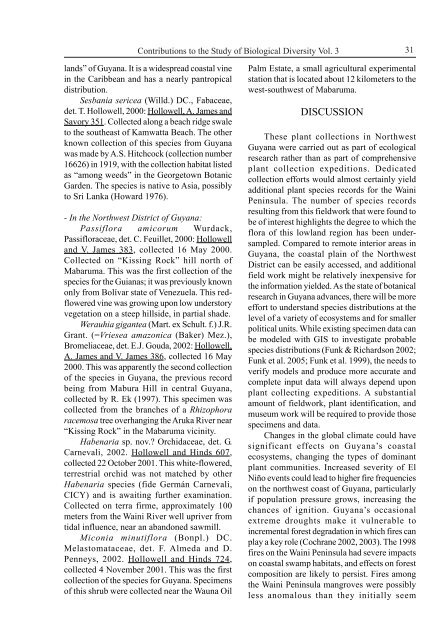Plant Community Structure, Fire Disturbance, and Recovery in ...
Plant Community Structure, Fire Disturbance, and Recovery in ...
Plant Community Structure, Fire Disturbance, and Recovery in ...
Create successful ePaper yourself
Turn your PDF publications into a flip-book with our unique Google optimized e-Paper software.
Contributions to the Study of Biological Diversity Vol. 3<br />
l<strong>and</strong>s” of Guyana. It is a widespread coastal v<strong>in</strong>e<br />
<strong>in</strong> the Caribbean <strong>and</strong> has a nearly pantropical<br />
distribution.<br />
Sesbania sericea (Willd.) DC., Fabaceae,<br />
det. T. Hollowell, 2000: Hollowell, A. James <strong>and</strong><br />
Savory 351. Collected along a beach ridge swale<br />
to the southeast of Kamwatta Beach. The other<br />
known collection of this species from Guyana<br />
was made by A.S. Hitchcock (collection number<br />
16626) <strong>in</strong> 1919, with the collection habitat listed<br />
as “among weeds” <strong>in</strong> the Georgetown Botanic<br />
Garden. The species is native to Asia, possibly<br />
to Sri Lanka (Howard 1976).<br />
- In the Northwest District of Guyana:<br />
Passiflora amicorum Wurdack,<br />
Passifloraceae, det. C. Feuillet, 2000: Hollowell<br />
<strong>and</strong> V. James 383, collected 16 May 2000.<br />
Collected on “Kiss<strong>in</strong>g Rock” hill north of<br />
Mabaruma. This was the first collection of the<br />
species for the Guianas; it was previously known<br />
only from Bolívar state of Venezuela. This redflowered<br />
v<strong>in</strong>e was grow<strong>in</strong>g upon low understory<br />
vegetation on a steep hillside, <strong>in</strong> partial shade.<br />
Werauhia gigantea (Mart. ex Schult. f.) J.R.<br />
Grant. (=Vriesea amazonica (Baker) Mez.),<br />
Bromeliaceae, det. E.J. Gouda, 2002: Hollowell,<br />
A. James <strong>and</strong> V. James 386, collected 16 May<br />
2000. This was apparently the second collection<br />
of the species <strong>in</strong> Guyana, the previous record<br />
be<strong>in</strong>g from Mabura Hill <strong>in</strong> central Guyana,<br />
collected by R. Ek (1997). This specimen was<br />
collected from the branches of a Rhizophora<br />
racemosa tree overhang<strong>in</strong>g the Aruka River near<br />
“Kiss<strong>in</strong>g Rock” <strong>in</strong> the Mabaruma vic<strong>in</strong>ity.<br />
Habenaria sp. nov.? Orchidaceae, det. G.<br />
Carnevali, 2002. Hollowell <strong>and</strong> H<strong>in</strong>ds 607,<br />
collected 22 October 2001. This white-flowered,<br />
terrestrial orchid was not matched by other<br />
Habenaria species (fide Germán Carnevali,<br />
CICY) <strong>and</strong> is await<strong>in</strong>g further exam<strong>in</strong>ation.<br />
Collected on terra firme, approximately 100<br />
meters from the Wa<strong>in</strong>i River well upriver from<br />
tidal <strong>in</strong>fluence, near an ab<strong>and</strong>oned sawmill.<br />
Miconia m<strong>in</strong>utiflora (Bonpl.) DC.<br />
Melastomataceae, det. F. Almeda <strong>and</strong> D.<br />
Penneys, 2002. Hollowell <strong>and</strong> H<strong>in</strong>ds 724,<br />
collected 4 November 2001. This was the first<br />
collection of the species for Guyana. Specimens<br />
of this shrub were collected near the Wauna Oil<br />
31<br />
Palm Estate, a small agricultural experimental<br />
station that is located about 12 kilometers to the<br />
west-southwest of Mabaruma.<br />
DISCUSSION<br />
These plant collections <strong>in</strong> Northwest<br />
Guyana were carried out as part of ecological<br />
research rather than as part of comprehensive<br />
plant collection expeditions. Dedicated<br />
collection efforts would almost certa<strong>in</strong>ly yield<br />
additional plant species records for the Wa<strong>in</strong>i<br />
Pen<strong>in</strong>sula. The number of species records<br />
result<strong>in</strong>g from this fieldwork that were found to<br />
be of <strong>in</strong>terest highlights the degree to which the<br />
flora of this lowl<strong>and</strong> region has been undersampled.<br />
Compared to remote <strong>in</strong>terior areas <strong>in</strong><br />
Guyana, the coastal pla<strong>in</strong> of the Northwest<br />
District can be easily accessed, <strong>and</strong> additional<br />
field work might be relatively <strong>in</strong>expensive for<br />
the <strong>in</strong>formation yielded. As the state of botanical<br />
research <strong>in</strong> Guyana advances, there will be more<br />
effort to underst<strong>and</strong> species distributions at the<br />
level of a variety of ecosystems <strong>and</strong> for smaller<br />
political units. While exist<strong>in</strong>g specimen data can<br />
be modeled with GIS to <strong>in</strong>vestigate probable<br />
species distributions (Funk & Richardson 2002;<br />
Funk et al. 2005; Funk et al. 1999), the needs to<br />
verify models <strong>and</strong> produce more accurate <strong>and</strong><br />
complete <strong>in</strong>put data will always depend upon<br />
plant collect<strong>in</strong>g expeditions. A substantial<br />
amount of fieldwork, plant identification, <strong>and</strong><br />
museum work will be required to provide those<br />
specimens <strong>and</strong> data.<br />
Changes <strong>in</strong> the global climate could have<br />
significant effects on Guyana’s coastal<br />
ecosystems, chang<strong>in</strong>g the types of dom<strong>in</strong>ant<br />
plant communities. Increased severity of El<br />
Niño events could lead to higher fire frequencies<br />
on the northwest coast of Guyana, particularly<br />
if population pressure grows, <strong>in</strong>creas<strong>in</strong>g the<br />
chances of ignition. Guyana’s occasional<br />
extreme droughts make it vulnerable to<br />
<strong>in</strong>cremental forest degradation <strong>in</strong> which fires can<br />
play a key role (Cochrane 2002, 2003). The 1998<br />
fires on the Wa<strong>in</strong>i Pen<strong>in</strong>sula had severe impacts<br />
on coastal swamp habitats, <strong>and</strong> effects on forest<br />
composition are likely to persist. <strong>Fire</strong>s among<br />
the Wa<strong>in</strong>i Pen<strong>in</strong>sula mangroves were possibly<br />
less anomalous than they <strong>in</strong>itially seem
















